 W
WSeljuk architecture comprises the building traditions used by the Seljuk dynasty, when it ruled most of the Middle East and Anatolia during the 11th to 13th centuries. The Great Seljuk Empire contributed significantly to the architecture of Iran and surrounding regions, introducing innovations such as the symmetrical four-iwan layout and the first widespread creation of state-sponsored madrasas. Their buildings were generally constructed in brick, with decoration created using brickwork, tiles, and carved stucco.
 W
WAğzıkara Han is a historic Seljuk-era caravanserai in Turkey. It is located in the Ağzıkarahan village in the province of Aksaray.
 W
WIn Iranian architecture, banna'i is an architectural decorative art in which glazed tiles are alternated with plain bricks to create geometric patterns over the surface of a wall or to spell out sacred names or pious phrases. This technique originated in Syria and Iraq in the 8th century, and matured in the Seljuq and Timurid era, as it spread to Iran, Anatolia and Central Asia.
 W
WBuruciye Medrese or Buruciye Madrasah is a former medrese, in Sivas, Turkey. It was built during the reign of Seljuk sultan Gıyaseddin Keyhüsrev III in 1271.
 W
WÇifte Minareli Medrese, literally "Double Minaret Madrasah", is a former medrese located in Sivas, Turkey. It was built in 1271/2. It was commissioned by Şemseddin Cüveynî an Ilkhanid vizier.
 W
WDiyanet Center of America (DCA) is a non-profit organization funded by the Turkish government that is based in Lanham, Maryland, serving the needs of the Muslim community in the Washington Metropolitan Area. The center holds regular Friday congregational prayers, Ramadan dinners, religious holiday celebrations – including Mawlid – and various other social, cultural, and religious activities.
 W
WGökmedrese or Gök Medrese, is a 13th-century Anadolu Selçuklu medrese, in Tokat, Turkey. This splendid piece of Seljuk architecture for years hosted the "Tokat Müzesi", an archaeological and ethnographical museum, until that moved in 2012 to a location in the bedesten area.
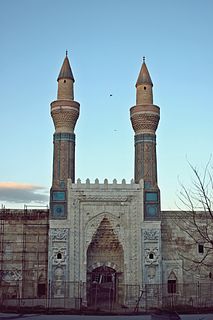 W
WGökmedrese or Gök Medrese, also known as Sahibiye Medresesi, is a 13th-century medrese, an Islamic educational institution, in Sivas, Turkey.
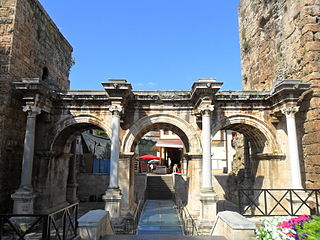 W
WHadrian's Gate or Üçkapılar is a triumphal arch located in Antalya, Turkey, which was built in the name of the Roman emperor Hadrian, who visited the city in the year 130. It is the only remaining entrance gate in the walls that surround the city and harbor.
 W
WHudavend Hatun Türbe or Huvand Hatun Türbe is a 14th-century Seljuk Kümbet in Nigde, Turkey.
 W
WThe Imam al-Bahir Mosque was a historic mosque located in the city of Mosul, Iraq. The mosque was commissioned by the Zangid ruler Badr al-Din Lu'lu' in the same year of his death.
 W
WThe Jameh Mosque of Golpayegan is one of the important mosques of the Seljukid era and one of the large mosques in Iran. In view of its construction date, it may be said that its Iranian Islamic architecture was a model for building other large mosques specially the mosques, which were in the territory of seljukid dynasty. This mosque is located in the Masjed Jameh street in Golpayegan.
 W
WThe Jameh Mosque of Saveh is a Seljuk-era mosque, located in Saveh, Iran. This monument was built in the 12th century, coinciding with the establishment of the city itself.
 W
WKarat Minaret a minaret and is about 25 km south of Taybad, Iran, in the village with the same name. It was built in Seljuk period.
 W
WThe Kesik Minare Cami, Korkut Cami or Cumanın Cami standing in the streets of Kaleiçi in southern Turkey, was originally built as a Roman temple in the 2nd century AD. In the 7th century, it was converted into a Byzantine church in honor of the Virgin Mary, but it was heavily damaged in the 7th century during the Arab invasions. In the 9th century it was repaired again. The minaret was added in the early 13th century when the Sultanate of Rum established their rule in Antalya and converted the church into a mosque. In 1361, when the crusader king of Cyprus took Antalya from the Seljuks, it was consecrated a church again, only to become a mosque once more during the rule of Şehzade Korkut, son of the Ottoman sultan Bayezid II. The main building was destroyed in a fire in 1800, but the surviving minaret, located today on Kaleiçi Hespçi Street, is known as the Kesik Minare.
 W
WThe Kharraqan towers are a pair of mausolea built in 1067 and 1093, in the Kharraqan region of northern Iran, near Qazvin. They are notable for being an early example of geometric ornament, an early example of double domes, and one of the earlier tomb towers that appeared in Seljuq Iran during the 11th century.
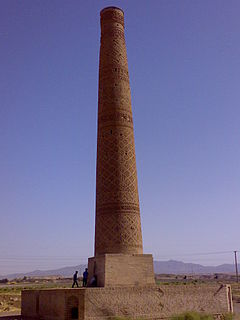 W
WKhosrogerd Minaret is a 12th-century tower located 10 kilometres (6.2 mi) to the west of Sabzevar, Iran, and is all that remains of the Silk Road town of Khosrogerd, destroyed by the Mongols in 1220 AD. It is an example of Seljuk architecture.
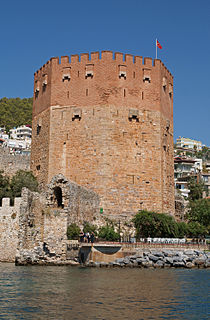 W
WThe Kızıl Kule is a historical tower in the Turkish city of Alanya. The building is considered to be the symbol of the city, and is even used on the city's flag.
 W
WKubat Pasha Madrasa is a historic madrasa building in Tarsus district of Mersin Province, southern Turkey.
 W
WThe Mausoleum of Imam Hasan of Basra is a historic shrine in Basra commemorating the renowned ulama Hasan of Basra. Hasan of Basra was a Sunni Islamic ulama, nicknamed as Abi Sayeed, born two years before the end of the era of the second Caliph Umar. The mausoleum is located in the Zubayr district where many cemeteries are situated.
 W
WThe Mausoleum of Umar Suhrawardi, or the Mosque and the Tomb of the Sheikh Umar Suhrawardi, is a historic complex of a mausoleum and a mosque, located in Baghdad, Iraq. The complex dates back to the Abbasid era and is dedicated to Shahab al-Din Abu Hafs Umar Suhrawardi, the founder of Suhrawardiyya Sufi Order. The mosque is located between the Sheikh Umar Street and Bab al-Wastani of the Baghdad wall, in the southern part of Al-Rusafa. The mosque can be overlooked from the Muhammad al-Qasim Highway and approximately one kilometre away from the city center.
 W
WMausoleum of Yahya Abu al-Qasim was a historic shrine and mosque located in Mosul, Iraq. In 2014 the mosque and shrine were destroyed by an explosive device claimed by soldiers of the Islamic State of Iraq and Levant.
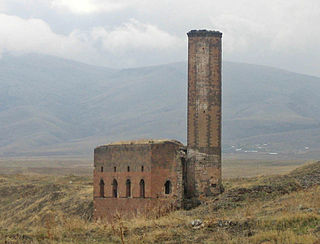 W
WMenucihr Mosque is a mosque in the Ani ancient city in Arpaçay of Kars Province, Turkey. It was built between 1072 and 1086 by Ebu’l Manuçehr Bey of the Kurdish Shaddadid dynasty. Restoration of the mosque started in june 2020.
 W
WSahip Ata Museum is an ethnography museum in Konya, Turkey. It is under the supervision of Directorate General of Foundations.
 W
WThe Seljuk stucco figures are stucco (plaster) figures found in the region of the Seljuk Empire, from its "golden age" between the 11th and 13th centuries. They decorated the inner walls and friezes of Seljuk palaces, together with other ornamented stucco ornaments, concealing the wall behind them. The figures were painted bright-colored and often gilded. They represented royal figures and were symbols of power and authority.
 W
WSultan Han is a large 13th-century Seljuk caravanserai located in the town of Sultanhanı, Aksaray Province, Turkey. It is one of the three monumental caravanserais in the neighbourhood of Aksaray and is located about 40 km (25 mi) west of Aksaray on the road to Konya.
 W
WSultan Han is a historic Seljuk-era caravanserai in Turkey, located 47 km northeast of Kayseri on the road to Sivas, in an area also known as Tuzhisar. It was built between 1232 and 1237 CE by Sultan Ala ad-Din Kayqubad I.
 W
WThe Tomb of Ahmad Sanjar is a mausoleum commemorating Ahmad Sanjar, a Seljuk ruler of Khorasan. It was built in 1157 in the medieval city of Merv in the Karakum Desert in Turkmenistan. Throughout his reign, Sanjar fought off several invasions and uprisings until finally being defeated by the Oghuz. After being sacked by the Oghuz, Merv declined and in 1221, the Mongols attacked it and burned down the mausoleum. It would later be restored by Soviet, Turkmen, and Turkish architects during the 20th and 21st centuries. The tomb is part of The State Historical and Cultural Park "Ancient Merv", a UNESCO World Heritage Site.
 W
WYakutiye Medrese is a historical 14th century Madrasa in Erzurum, Turkey. The madrasa was built in 1310 by order of a local governor of the Ilkhanids, Hoca Yakut, and it is named after him.
 W
WThe Zumurrud Khatun Mosque and Mausoleum, also known as the Mosque al Khaffafin, is a historic mosque and shrine located in Baghdad, Iraq. It dates back to the Abbasid era. It is located in Sheikh Maarouf Cemetery in the Karkh side of Baghdad. The site was built by Sitt Zubayda also known as Zumurrud Khatun in 1202, who was mother of the 34th Abbasid Caliph Al-Nasir, and wife of the 33rd Abbasid Caliph Al-Mustadi. She collected the waqf money from madrasas and built her mausoleum before her death, which is located in Karkh.